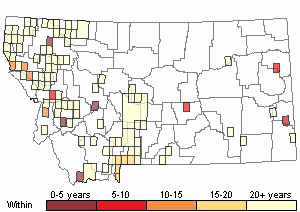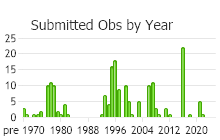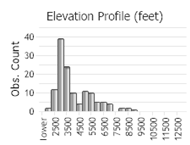View in other NatureServe Network Field Guides
NatureServe
Montana
Utah
Wyoming
Idaho
Wisconsin
British Columbia
South Carolina
Yukon
California
New York
Starry Syntrichia Moss - Syntrichia ruralis
Other Names:
Starry Twist Moss,
Tortula ruralis
General Description
Plants: Acrocarpous (Vitt 1988), growing in crowded to open mats or tufts, medium or more frequently large in size, green to brown (Lawton 1971), with reddish tones when wet, deep olive to nearly black or reddish when dry (Flowers 1973). Stems 1-8 cm in height, frequently branching, lacking a central strand (Lawton 1971).
Leaves: A little longitudinally pleated or twisted (Flowers 1973) or overlapping and flattened against the stem when dry, making a right angle from the stem and curved backward when wet, 3-4.5 mm in length, somewhat tongue-shaped (Lawton 1971), canaliculate (Flowers 1973); apex obtuse or curved, or occasionally shallowly notched; margins smooth or nearly so, recurved from base to tip or nearly so; costa typically jagged in back above papillae, which may be simple or forked to stellate, the costa extending beyond apex, forming a spiny hair-point (Flowers 1973) to 3 mm in length, which is transparent to rosy at the base (Lawton 1971).
Leaf Cells: Costa X-section: 2-3 guide cells; strong stereid band in front; 1-2 rows of cells on back side. Median and distal cells each with several papillae, these frequently short-forked; basal laminal cells (excluding margins) smooth, long, and transparent (Lawton 1971); distal cells strongly chlorophyllose and densely papillose, each supporting 2-12 papillae which may be C- or O-shaped, simple, forked or stellate; basal marginal cells typically green or red, small; basal medial cells larger, elongate, clear, with fine walls (Flowers 1973).
Range Comments
Having an extensive distribution throughout Canada and the United States, reaching well into Mexico. Eurasia, s South America, n and s Africa, Australia (Flowers 1973).
Observations in Montana Natural Heritage Program Database
Number of Observations: 302
(Click on the following maps and charts to see full sized version)
Map Help and Descriptions
Relative Density

Recency



 (Observations spanning multiple months or years are excluded from time charts)
(Observations spanning multiple months or years are excluded from time charts)
Habitat
Stones and soil, frequently calcareous, occasionally on trees (Lawton 1971), from moist shady habitats to open and dry exposures. Elevation: Low-lying land to high mountains (Flowers 1973).
Reproductive Characteristics
Seta 1-3 cm in length (Lawton 1971), reddish (Flowers 1973). Capsule reddish to brown, dark brown with age (Flowers 1973), upright, straight or only weakly bowed, the theca 3-4.5 mm in length; lid 1.5-2 mm in length (Lawton 1971); peristome teeth spiraled in 2 full rotations, heavily papillose, reddish. Dioicous (Flowers 1973).
Stewardship Responsibility
References
- Literature Cited AboveLegend:
 View Online Publication
View Online Publication Elliott, J.C. and A.K. Pipp. 2018. A Checklist of Montana Mosses (1880-2018). Updated 3 January, 2020. Montana Natural Heritage Program, Helena, Montana. 73 pp.
Elliott, J.C. and A.K. Pipp. 2018. A Checklist of Montana Mosses (1880-2018). Updated 3 January, 2020. Montana Natural Heritage Program, Helena, Montana. 73 pp. Flowers, S. 1973. Mosses: Utah and the West. Brigham Young University, Provo, Utah. 567 p.
Flowers, S. 1973. Mosses: Utah and the West. Brigham Young University, Provo, Utah. 567 p. Lawton, E. 1971. Moss Flora of the Pacific Northwest. Hattori Botanical Laboratory. Japan: Yamabuki-cho, Shinjuku-ku, Tokyo. 362 pages plus appendices.
Lawton, E. 1971. Moss Flora of the Pacific Northwest. Hattori Botanical Laboratory. Japan: Yamabuki-cho, Shinjuku-ku, Tokyo. 362 pages plus appendices. Vitt, D. J. Marsh, and R. Bovey. 1988. Mosses, Lichens & Ferns of Northwest North America. Seattle, WA: University of Washington Press. 296 p.
Vitt, D. J. Marsh, and R. Bovey. 1988. Mosses, Lichens & Ferns of Northwest North America. Seattle, WA: University of Washington Press. 296 p.
- Additional ReferencesLegend:
 View Online Publication
View Online Publication
Do you know of a citation we're missing? Aho, Ken Andrew. 2006. Alpine and Cliff Ecosystems in the North-Central Rocky Mountains. Ph.D. Dissertation. Bozeman, Montana: Montana State University. 343 p.
Aho, Ken Andrew. 2006. Alpine and Cliff Ecosystems in the North-Central Rocky Mountains. Ph.D. Dissertation. Bozeman, Montana: Montana State University. 343 p. Elliot, J. C. 1993. Second checklist of Montana mosses. Unpublished report. U.S. Forest Service, Region 1. Missoula, MT. 45 pp.
Elliot, J. C. 1993. Second checklist of Montana mosses. Unpublished report. U.S. Forest Service, Region 1. Missoula, MT. 45 pp. Lawton, E. 1971. Keys for the Identification of the Mosses on the Pacific Northwest. Reprinted from 'Moss Flora of the Pacific Northwest'. Published as Supplement No. 2 of the Journal of the Hattori Botanical Laboratory. Nichinan, Miyazaki, Japan. 66 pp.
Lawton, E. 1971. Keys for the Identification of the Mosses on the Pacific Northwest. Reprinted from 'Moss Flora of the Pacific Northwest'. Published as Supplement No. 2 of the Journal of the Hattori Botanical Laboratory. Nichinan, Miyazaki, Japan. 66 pp.
- Web Search Engines for Articles on "Starry Syntrichia Moss"





